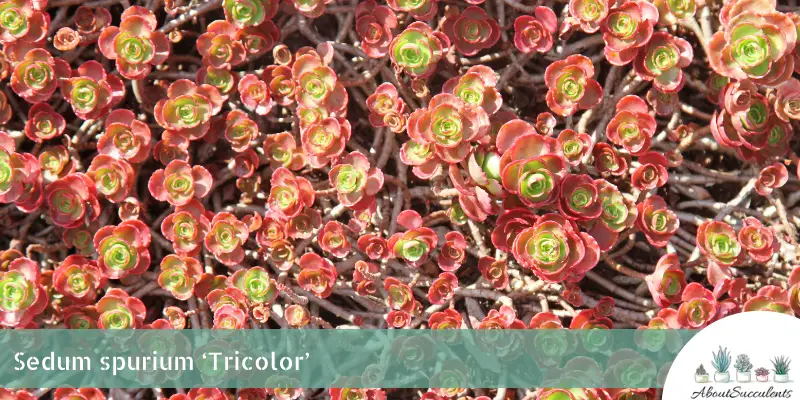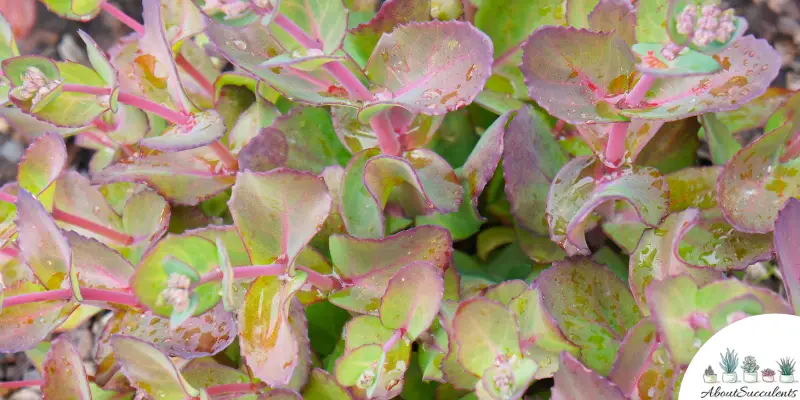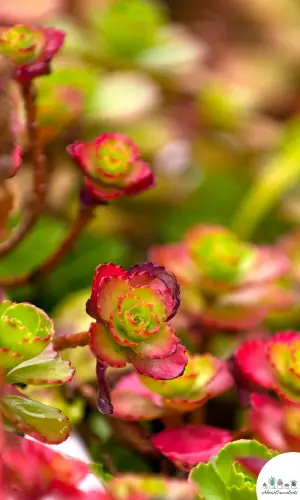
Sedum spurium is a sprawling succulent that’s easily distinguished by its adorable plump leaves that have a green center, and white margins with pink accents on its edges.
The interesting color combination has given this cold-hardy, durable stonecrop the nickname “Tricolor”. Sedum spurium also goes by other aliases such as Two-Row Stonecrop and Caucasian Stonecrop.
The nickname “Two-Row Stonecrop” was given because it describes how the leaves grow out of the center of the rosette and extend opposite of each other creating what looks like 2 rows.
Tricolor is a low-growing succulent plant that only reaches a height of 3 to 6-feet (91cm to 182.88cm) but it can spread out to as far as 18 to 24-feet (5.48m to 7.32m).
From late spring to mid-summer, Tricolor will produce small, star-shaped flowers that have a pinkish-red color that is less than an inch in diameter. The flowers will grow on top of vertical, reddish stems and can quite attract a few butterflies.
Sedum spurium “Tricolor” is a member of the Crassulaceae family and is native to a number of countries including Averliaz, France; Northern Iran, Georgia, and Northeast Turkey.
General Information
Also known as: Tricolor, Caucasian Stonecrop, and Two Row Stonecrop.
Plant Family: Crassulaceae
Origin: Averliaz, France; Northern Iran, Georgia, and Northeast Turkey
Height: 3 to 6-feet (91cm to 182.88cm)
Exposure: Preferably full sunlight but Tricolor will also thrive in partial sunlight.
Water Needs: Less is best; only water the soil when you have tested and confirmed that it’s 100% dry.
Soil Type: Cactus or commercial succulent mix with perlite, pumice, lava rock, and coarse sand added for better drainage.
Soil pH: 8 to 10
How To Grow And Care For Sedum spurium “Tricolor”

Because of its sprawling nature, Sedum spurium is popularly used by landscapers as ground cover. If you live in a region that has winter or frosty months, Tricolor is the ideal succulent for your outdoor garden.
As mentioned above, Sedum spurium is a cold-hardy succulent and can thrive in cold weather as long as temperatures don’t drop below -30° F (-34.4° C). If the mercury in your region drops lower than this temperature, it would be best to plant Tricolor in a basket and use it as a trailing succulent to adorn your home.
Growing and caring for Tricolor is easy and worry-free as long as you follow the simple tips outlined below.
Sunlight
Sedum spurium grows well whether it’s exposed to partial or full sunlight. To help the succulent achieve the maximum beauty of its tricolors and pinkish-red flowers, it would be best to provide it with full exposure to the sun’s rays in your outdoor garden.
If planted outdoors, avoid locations that are exposed to the scorching rays of the afternoon sun as these can burn the leaves of Two Row Stonecrop.
Should you decide to grow Sedum spurium inside your home as a hanging succulent, make sure that at the very least it gets partial sunlight for up to 4 hours every day.
Watering

Of all the tips we have on growing and caring for Sedum spurium, special attention must be given to its watering schedule.
Like all succulents, giving Tricolor more water than it needs is detrimental to its health and might potentially kill the plant.
The fact that succulents don’t need frequent watering is one reason why their popularity has grown to such heights. You don’t have to worry about not watering Tricolor for weeks because it’s drought-tolerant and will survive.
To find out if Two-Row Stonecrop needs water, insert a stick an inch into its topsoil. If the stick comes out dry, you can give the soil a thorough soaking. Keep in mind to water the soil and not the plant.
Sedum spurium will require less water during the cold months because the soil stays moist for a longer period of time.
Pot and Soil
When choosing a pot for Sedum spurium, prioritize drainage. You want to house Tricolor in a pot that allows moisture to escape from the soil as fast as possible. The best pots are ones that are made from unglazed ceramic or terracotta because the materials make it easier to dry out the soil.
You must also make sure that the pot has a drain hole with a mesh cover to filter out the excess water without losing much soil.
A cactus mix or a commercially available succulent mix are good choices of soil to plant Tricolor in. With better drainage in mind, add ingredients such as perlite, pumice, lava rock, and coarse sand to help keep water away from the roots.
How To Propagate Sedum spurium “Tricolor”
Are you thinking of adding to the number of Sedum spurium in your succulent garden? Are you planning on having a few pots of Tricolor inside your home? There’s no need to buy more plants as Sedum spurium is easy to propagate through stem cuttings taken from the top half of the plant.
Step 1: Use a sterile knife or pruning shears to cut healthy stems. Remove all the leaves from the lower part of the stems.
Step 2: Leave the cuttings to dry for 3-4 days in a cool and shaded area. Wait for the cut side of the stems or stem wounds to harden and callus. For best results, you can dip your cuttings in a rooting hormone before planting them.
Step 3: Fill a terracotta pot or bed with a fresh succulent soil mix combined with gritty materials and plant your cuttings.
Step 4: Place the pots in a location where they could receive filtered sunlight. Moisten the soil once or twice a day because your baby succulents need lots of moisture to grow well. Once the babies develop strong roots, you can transfer them to their individual pots.
Frequently Asked Questions
Is Sedum spurium “Tricolor” Toxic For Cats And Dogs?
Sedum spurium isn’t included in the list of plants that are toxic for cats and dogs in the website of the American Society for the Prevention of Cruelty to Animals (ASPCA).
However, this isn’t a complete list and there have been reports of cats and dogs experiencing discomfort after accidentally ingesting a part of Tricolor.
To be sure, when growing Sedum spurium indoors, place them in an area that can’t be reached by your pets. This shouldn’t be a problem as Two-Row Stonecrop is normally used as a hanging succulent indoors.
You might want to grow Two-Row Stonecrop in hanging baskets in the garden if you have pets.
Why Is My Sedum spurium “Tricolor” Dying?
If your Sedum spurium “Tricolor” is looking pale and weak, it might be close to death. The number one reason succulents die is overwatering. Pest infestation is another one but that problem isn’t as serious as giving Two-Row Stonecrop too much water.
Overwatering
The roots of a succulent cannot be kept in a moist environment for a long time because its cells can erupt and expose the entire plant to contamination. Bacteria can enter through the roots and spread throughout the stems and leaves quickly.
A sure sign of infection setting in is discoloration on the leaves and stems. If you see the plant developing dark-yellow or blackish patches, act right away,
Cut off the infected sections with a sterilized pair of garden shears. Remove the Tricolor from the pot and shake away the excess soil. Inspect the roots and cut off the ones that have rotted away.
Place the succulent in a dry area and prepare a new pot by adding fresh cactus soil. Replant Sedum spurium and avoid overwatering its soil.
Pest Infestation
Sedum spurium attracts mealybugs and aphids because of its nutritious sap. Snails can also be a threat as these creatures like eating their leaves.
You can keep pests away by spraying Two-Row Stonecrop with a natural insecticide such as neem oil. Also, remove leaves that have fallen and collected near the plant.
Yes, Tricolor will bloom small, star-shaped flowers that have a pinkish-red color that is less than an inch in diameter from late spring to mid-summer.
Last Updated on June 9, 2022 by Sofia Lara